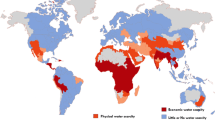Abstract
India has one of the largest and most ambitious irrigation programme in the world with net irrigated area exceeding 47 million hectares. However, the overall project efficiency from the headwork to the farmer’s field has been quite low which leads to not only poor utilization of irrigation potential created at huge cost, but also aggravates the degradation of soil and water resources and thereby endangers the sustainability of agricultural production system. As the cost of creating additional irrigation potential in terms of financial, human and environmental aspects has increased tremendously, need of the hour is to increase the irrigation efficiency of existing projects and use saved water for irrigating new areas or meeting the demand of non-agricultural sector. The contribution of application efficiency to poor irrigation efficiency is quite high and therefore increasing application efficiency by a shift in application method from surface to pressurized system has potential of vastly improving irrigation efficiency. To evaluate feasibility of this concept, a pilot study was initiated at Water Technology Centre for Eastern Region, Bhubaneswar, on one outlet of a minor irrigation command. The system has been designed in such a way that it provides pipe conveyance and surface irrigation for rice cultivation during monsoon season and pressurized irrigation during post monsoon period through a hybrid system of sprinkler and drip with four outlets for sprinkler irrigating 2.8 ha area and two outlets for drip irrigating 1.9 ha area. The system is also capable of providing irrigation through drip to part of a command during summer for third crop using water stored in service reservoir after the canal is closed in first week of April. To take care of sediment in the canal water, there are three stages of filtration: first by hydrocyclone filter which filters heavy suspended materials viz. sand, silt, etc., then by the sand filter and finally by the screen filter. The filtration at three stages reduces the turbidity to the desired level. It has been found that three-stage filtration reduced the turbidity to two NTU which is within permissible limit. Considering the cost of water saved, a benefit-cost ratio of the system was found out to be 1.126. This B: C ratio can be further increased by increasing the productivity of the fish and papaya in service reservoir area and better crop management during summer season.
Similar content being viewed by others
References
Battikhi AM, Abu-Hammad AH (1994) Comparison between the efficiencies of surface and pressurized irrigation systems in Jordan. Irrig Drain Syst 8:109–121
Biswal AK (2004) Studies on hydraulics of hybrid pressurized system based on canal water. Unpublished M.Tech. thesis, Orissa University of Agriculture and Technology, Bhubaneswar, Orissa, India
Bos MG, Nugteren J (1990) On farm irrigation efficiencies. International Institute for Land Reclamation and Improvement, Netherlands
Bucks DA, Nakayama FS, Warrick AW (1982) Principles, practices and potentialities of trickle irrigation. In: Hillel D (ed) Advances in irrigation. Academic, New York, pp 220–291
Dechmi F, Playan E, Faci JM, Tejero M (2003a) Analysis of an irrigation district in northeastern Spain: I: characterization and water use assessment. Agric Water Manag 61:75–92
Dechmi F, Playan E, Faci JM, Tejero M, Bercero A (2003b) Analysis of an irrigation district in northeastern Spain: II. Irrigation evaluation, simulation and scheduling. Agric Water Manag 61:93–109
Lecina S, Playa’n E, Isidoro D, Dechmi F, Causape J, Faci JM (2005) Irrigation evaluation and simulation at the irrigation district V of Bardenas (Spain). Agric Water Manag 73(3):223–245
Magar SS, Mane MS, Shirke VS, Patil M (2007) Micro-irrigation strategies and perspective in India. J Water Manag 15(2):107–113
Michael AM (1978) Irrigation theory and practice. Vikas, New Delhi
Navalwala BN (1991) Waterlogging and its related issues in India. J Irrigation and Power, 55–64
Playan E, Maetos L (2006) Modernization and optimization of irrigation systems to increase water productivity. Agric Water Manag 80:110–116
Playan E, Slatni A, Castillo R, Faci JM (2000) A case study for irrigation modernisation: II scenario analysis. Agric Water Manag 42:335–354
Rowshon MK, Amin MSM, Lee TS, Shariff ARM (2009) GIS-integrated rice irrigation management information system for a river-fed scheme. Water Resour Manage 23(14):2841–2866
Sanmuganathan K, Bolton P (1988) Water management in third world irrigation schemes—lesson from the field. ODU Bull., 11, Hydraulic Research, London, UK
Srivastava RC, Ahmed M (1998) Design criteria for canal supply based pressurized irrigation system in high rainfall areas of eastern India. Progress in micro-irrigation research and development in India. In: Proc. nat. seminar on micro-irrigation research in India: status and perspectives for 21st century, 27–28 July, 1998, Bhubaneswar, pp 90–95
Srivastava RC, Mohanty S, Singandhupe RB, Biswal AK, Ray LIP, Sahoo D (2006) Studies on canal water based pressurized irrigation system in a minor irrigation command. J Agric Eng 43(4):28–35
Vandersypen K, Verbist B, Keita ACT, Raes D, Jamin JY (2009) Linking performance and collective action—the case of the Office du Niger irrigation scheme in Mali. Water Resour Manage 23(1):153–168
Walters W, Bos MG (1989) Irrigation performance, assessment and irrigation efficiency. Annual report 1989. International Institute for Land Reclamation and Improvement, ILRI, Wageningen
Zardari NH, Cordery I (2009) Water productivity in a rigid irrigation delivery system. Water Resour Manage 23(6):1025–1040
Author information
Authors and Affiliations
Corresponding author
Rights and permissions
About this article
Cite this article
Srivastava, R.C., Mohanty, S., Singandhuppe, R.B. et al. Feasibility Evaluation of Pressurized Irrigation in Canal Commands. Water Resour Manage 24, 3017–3032 (2010). https://doi.org/10.1007/s11269-010-9592-1
Received:
Accepted:
Published:
Issue Date:
DOI: https://doi.org/10.1007/s11269-010-9592-1




